Ѕез заголовка |
ерамика (греч. keramike – гончарное искусствo, от keramos – глина) – наименование любых бытовых или художественных изделий, выполненных из глины или содержащих глину смесей, обожженных в печи или высушенных на солнце. керамике относ€тс€ гончарные издели€, терракота, майолика, фа€нс, каменна€ масса, фарфор. Ћюбой предмет, сформованный из природной глины и закрепленный сушкой на солнце или обжигом, считаетс€ гончарным изделием. ‘арфор представл€ет собой особый вид гончарного издели€. ѕросвечивающий, обладающий стекловидным спекшимс€ черепком и в основе белый, насто€щий фарфор получают из специальных сортов глины, полевых шпатов и кварца или кварцевых заменителей.»зготовление гончарных изделий – древнее искусство, в большинстве культур предшествующее металлургии или даже ткачеству.¬ »талии с падением –имской империи высокоразвитое гончарное ремесло перестало существовать. ¬плоть до 13 в. изготавливались только грубые горшки с нацарапанными на них простейшими рисунками.
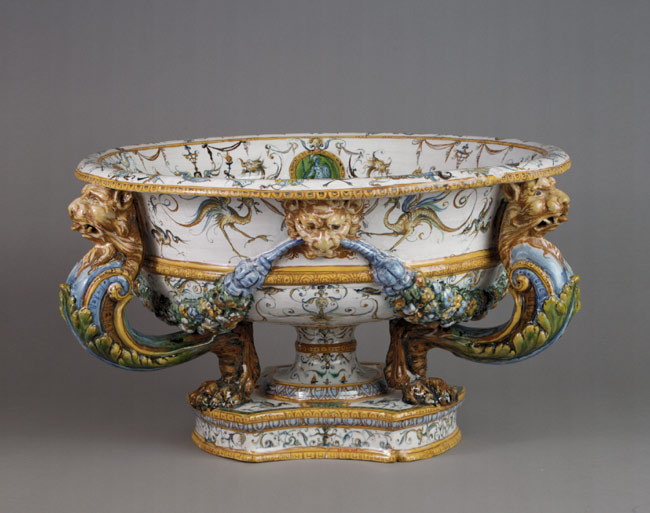
Wine Cistern, ca. 1562
Manufactured by the factory of Orazio Fontana, Urbino, Italy
Tin-glazed earthenware (majolica)
√лин€ные издели€.
ќбычно глин€ные издели€ оставались неглазурованными или покрывались простой, неровно наложенной зеленой или желтоватой поливой с оксидом меди или свинцом и были похожи на посуду, котора€ производилась в это врем€ по всей ≈вропе.
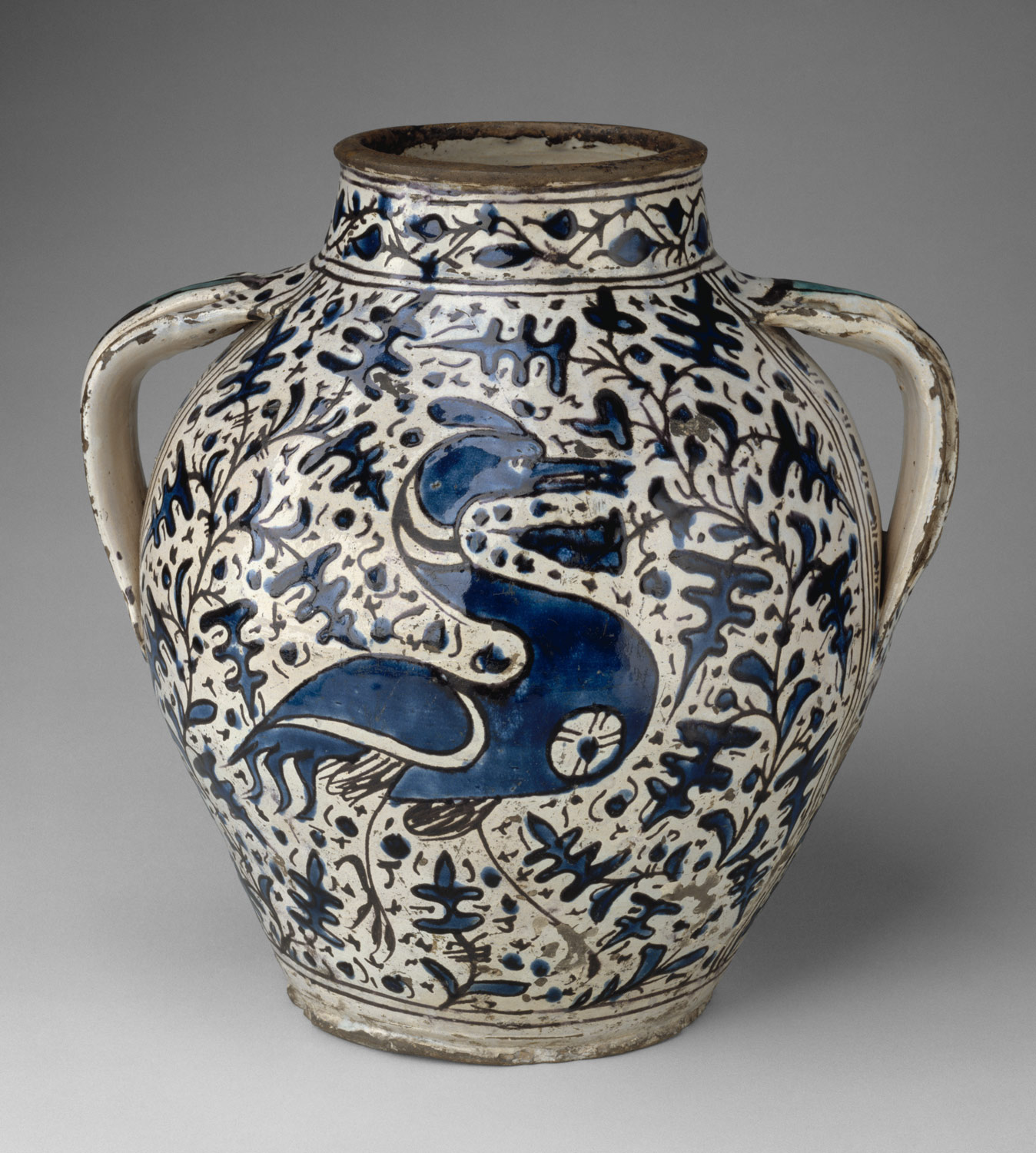
Apothecary Jar (Orciuolo), 1431 (?)
Florence, perhaps workshop of Giunta di Tugio (Italian, died ca. 1466)
Maiolica
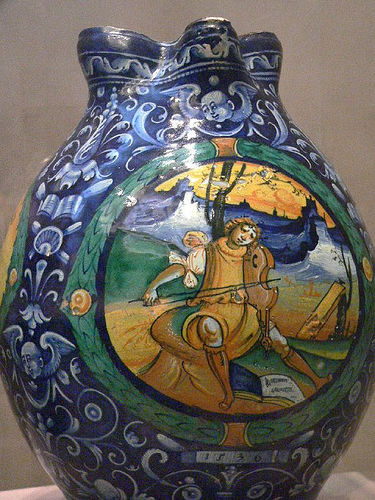
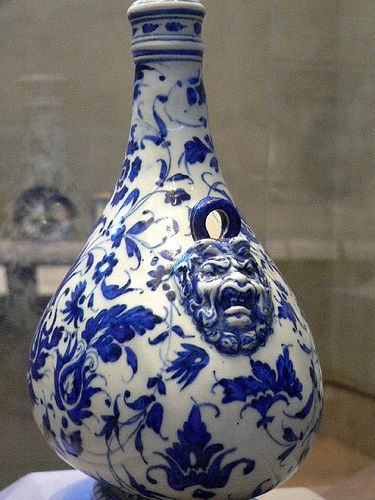
Ѕытова€ керамика.
—о второй половины 15 в. качество италь€нской керамической посуды заметно улучшилась. ¬ цветовой гамме по€вились кобальтовый синий, коричневый и желтый тона, а глазирование стало более ровным. ≈сли в более поздних французских и немецких кувшинах примен€лись красители, которые в процессе обжига сплавл€лись с эмалью, то в »талии поверх надглазурной росписи вторично накладывалась прозрачна€ стекловидна€ глазурь.




Childbirth bowl (scodella) with Aeneas Fleeing Troy (interior) and grotteschi (exterior); and tray (tagliere) with Pyramis and Thisbe (top) and Hercules and the Nemean Lion (bottom), ca. 1530–40
Baldassare Manara (Italian, Faenza, active 1529–46/47)
Tin-glazed earthenware (maiolica)
ћеццо-майолика.
¬торой тип италь€нской керамики получил название «меццо-майолика» (полумайолика). Ѕолее ранние издели€ этого типа покрывались тонким слоем белого ангоба и украшались грубоватым рисунком из звезд или крестов. ¬ конце 12 в. к этому покрытию стали добавл€ть оксид олова и, как и на Ѕлижнем ¬остоке, накладывать щелочную глазурь, но тонкую и худшего качества. Ёти грубо сформованные блюда и кувшины были предшественниками прославленной италь€нской майолики.
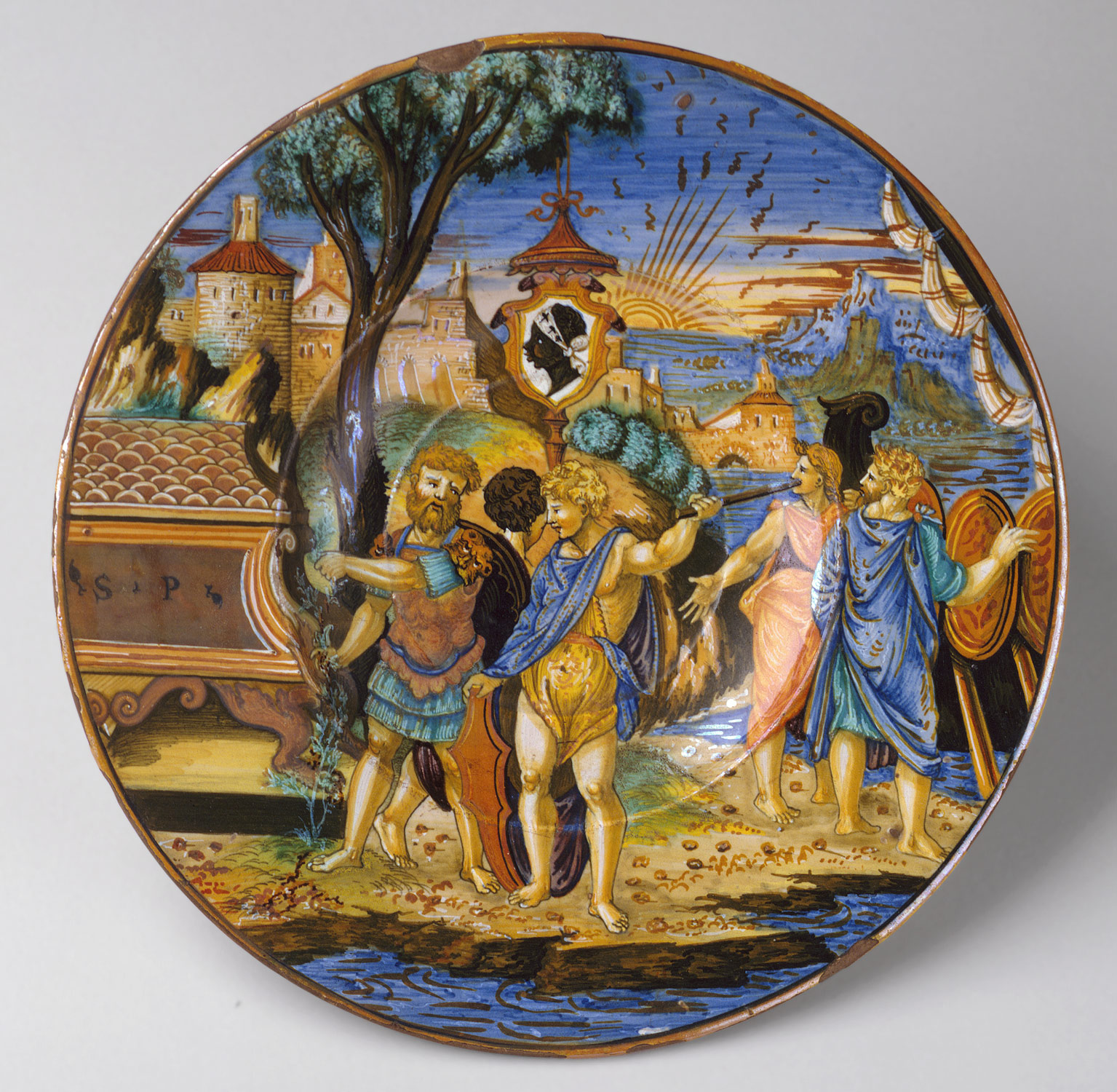
Plate (Piatto), 1532
Francesco Xanto Avelli da Rovigo (Italian, active 1530–42)
Maiolica
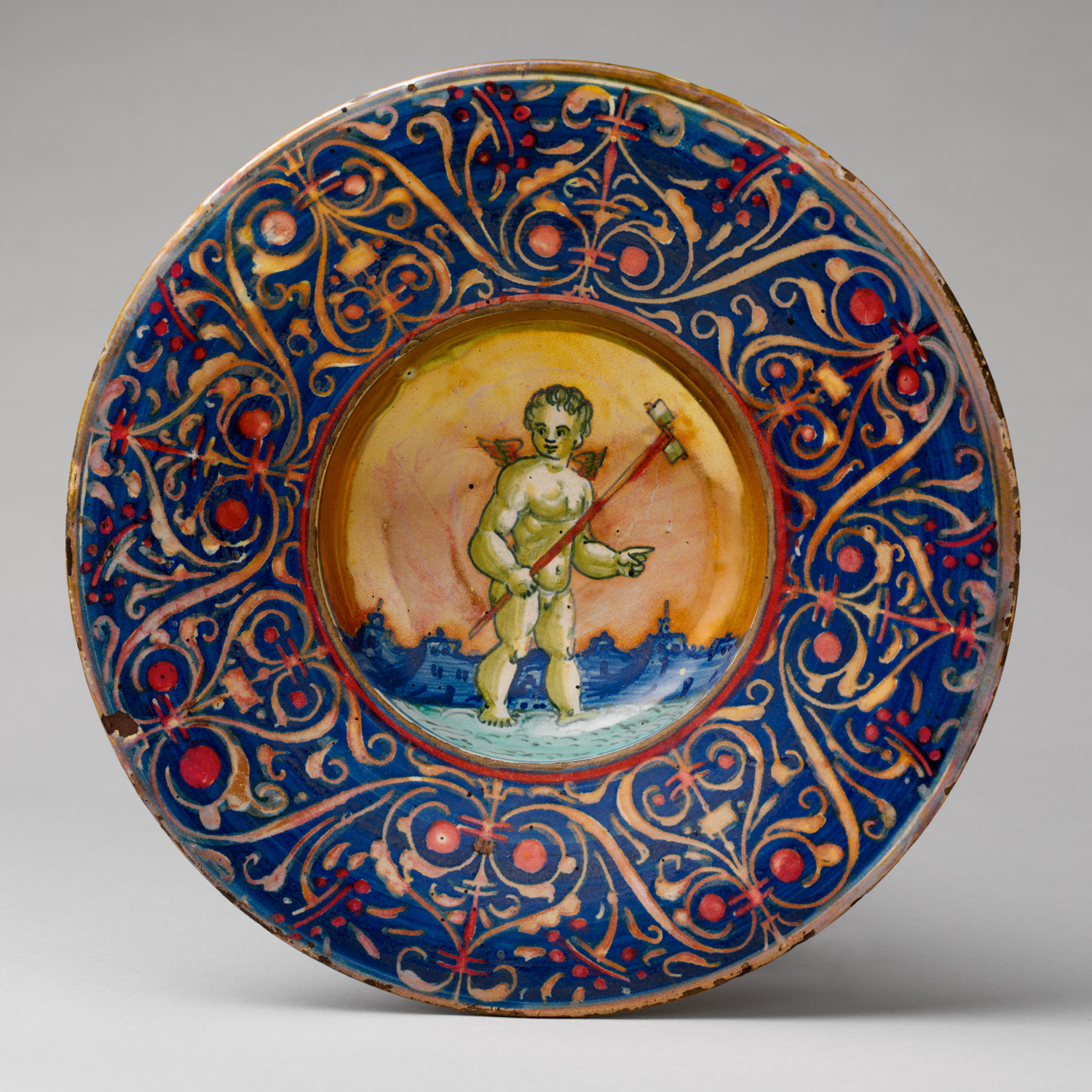
Bowl with a putto holding a pinwheel, ca. 1530
Workshop of Maestro Giorgio Andreoli (Italian, Gubbio, ca. 1465–1553)
Tin-glazed earthenware (maiolica)
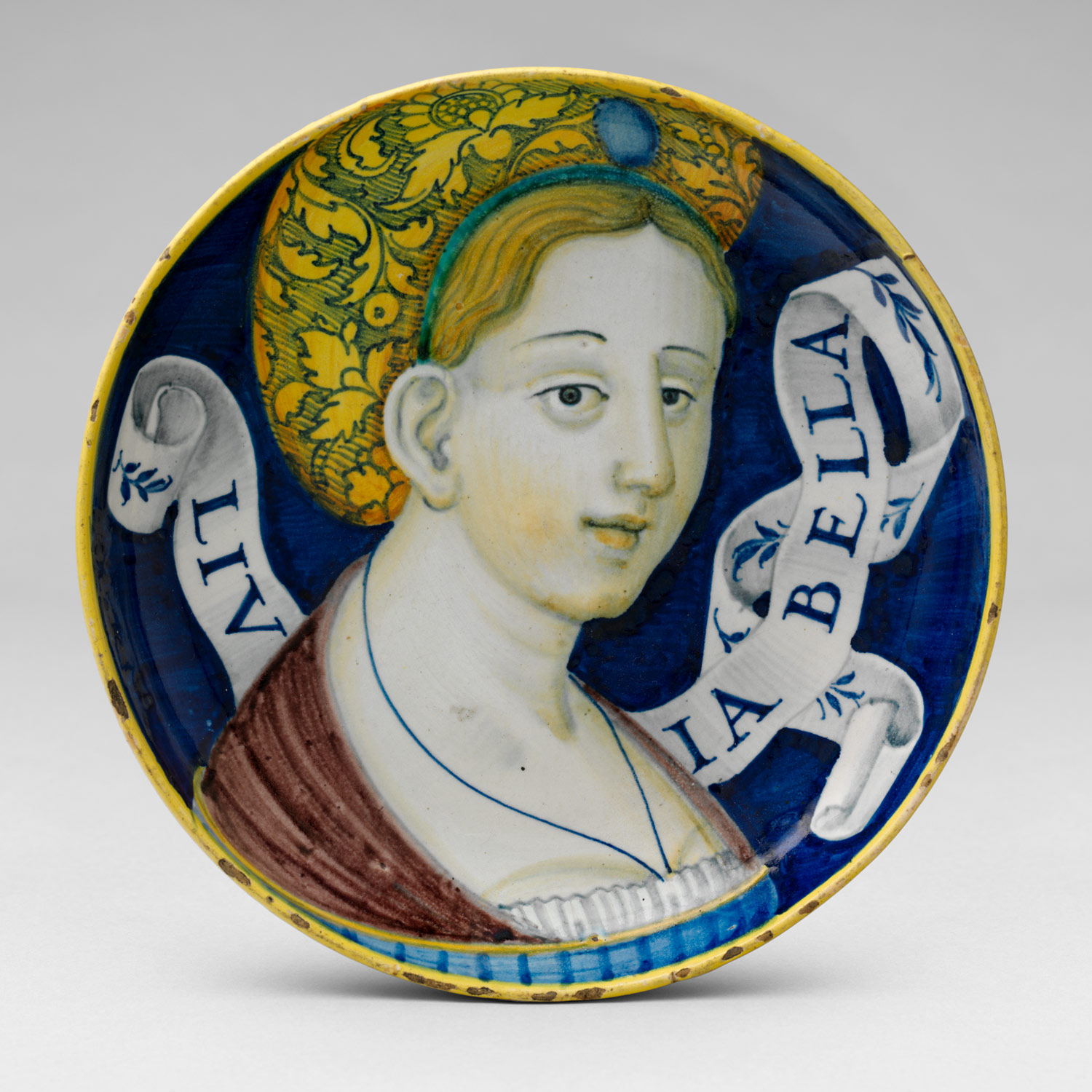
Low-footed bowl with bust of a woman, ca. 1530
Urbino or Castel Durante
Tin-glazed earthenware (maiolica)
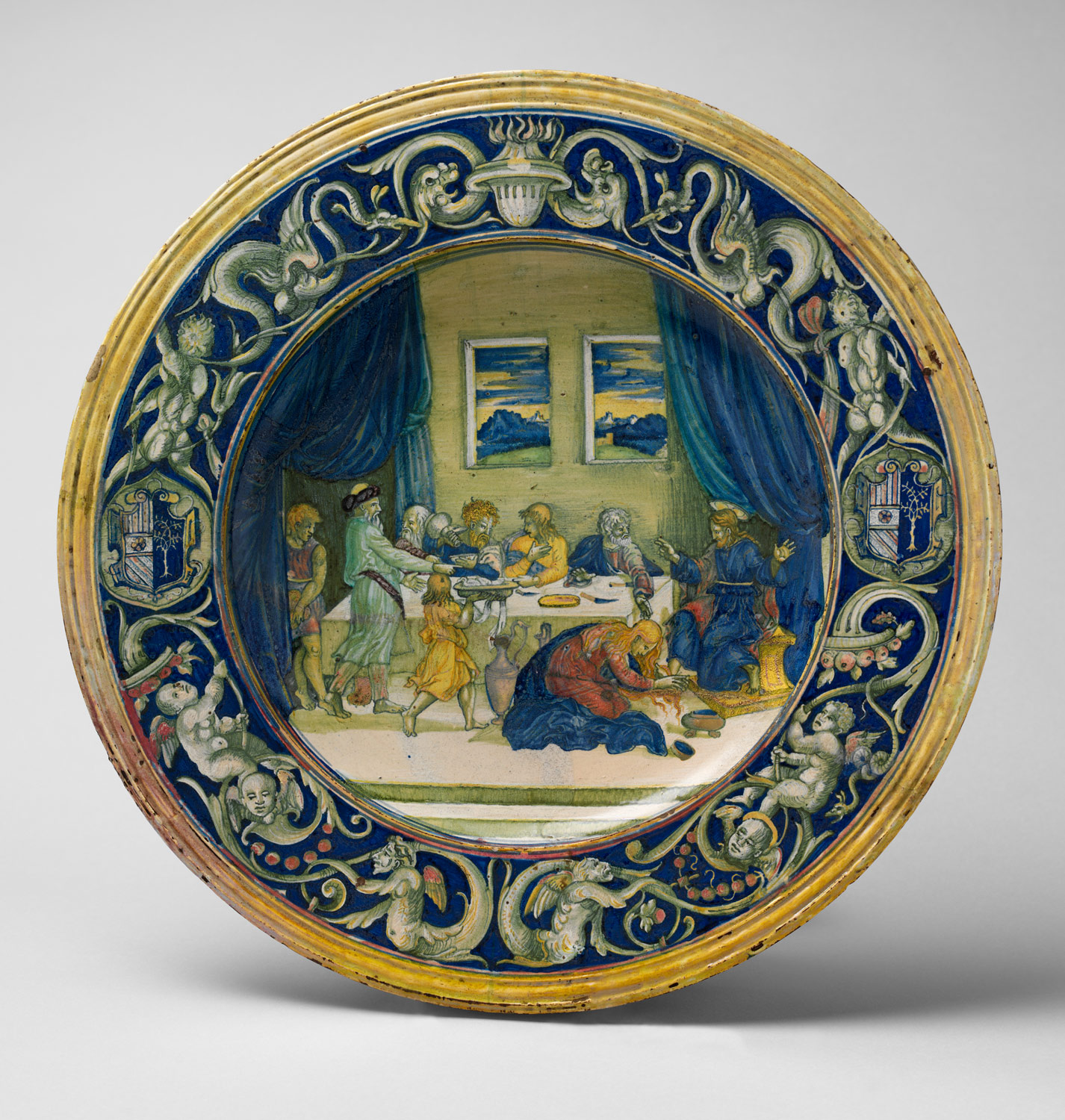
Dish with scene of Christ at Supper with Simon the Pharisee and with the Arms of Orsini Impaling della Rovere, 1528
Circle of Nicola da Urbino (Italian, ca. 1480–1538); lustered in the workshop of Maestro Giorgio Andreoli (Gubbio)
Tin-glazed earthenware (maiolica ).
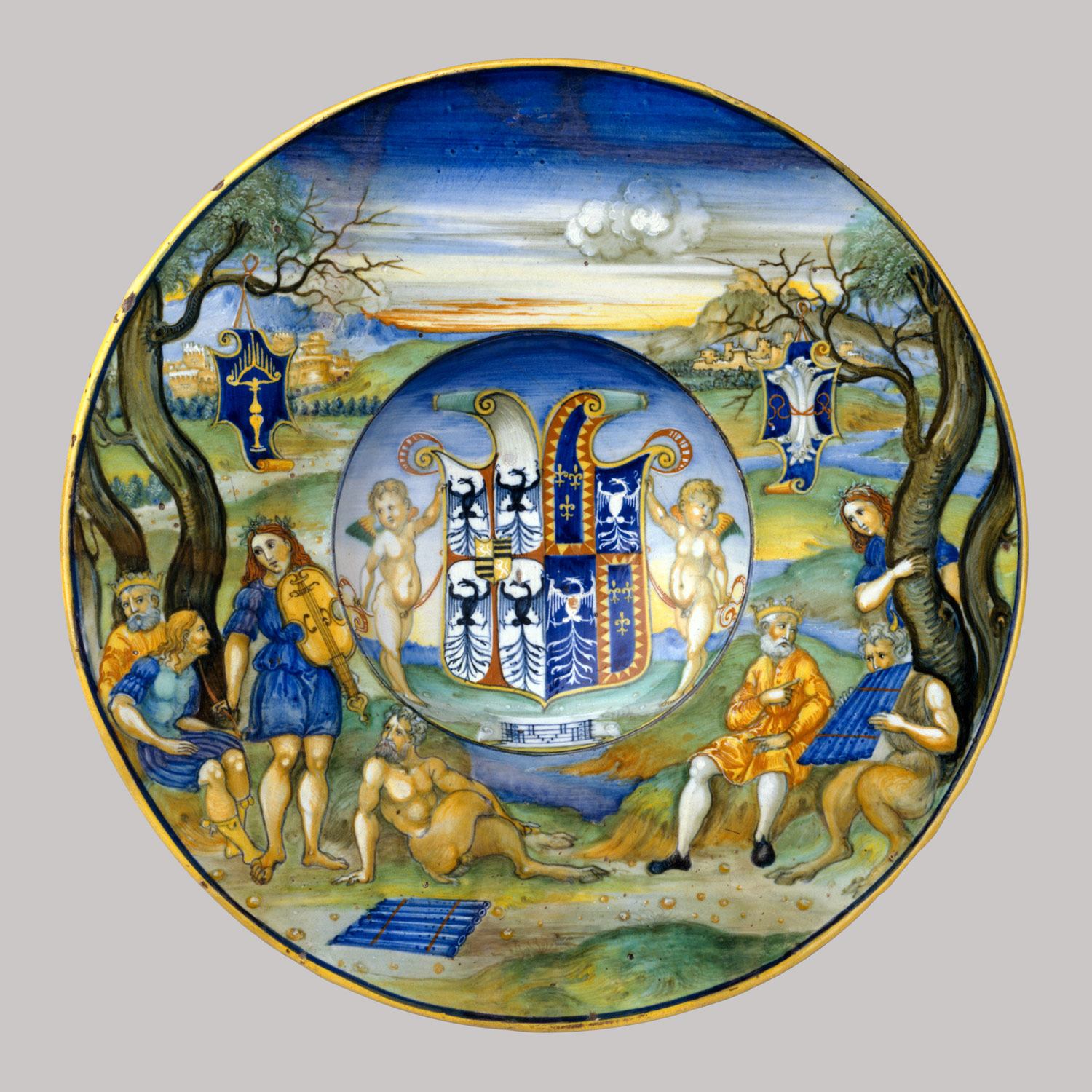
Armorial Plate (Tondino), ca. 1520–25 (or 1519?)
Nicolò da Urbino (probably Nicola di Bagriele Sbarage) (Italian, active from ca. 1520, died 1537/38)
Majolica


Pair of low-footed bowls with busts of Ruggieri and Filomena, ca. 1520–25
Italy; Urbino or Castel Durante
Tin-glazed earthenware (maiolica)
ћайолика.
¬ 12–13 вв. »тали€ вела широкую торговлю с »спанией и Ѕлижним ¬остоком, откуда, вместе с испано-мавританской керамикой, привозились белые издели€ с люстровой росписью. ¬ 1499 покрытые олов€нной глазурью люстровые издели€ из города ћанисеса доставл€лись на корабл€х в порты »спании, —еверной јфрики и »талии через остров ћайорка. »таль€нцы полагали, что эти издели€ там и производились, и стали называть собственные замечательные издели€ эпохи –енессанса майоликой.–азвитие расписной майолики (керамических изделий, покрытых олов€нной глазурью) отметило переход италь€нской керамики от стадии грубого средневекового ремесла к высокопрофессиональному искусству –енессанса. –анее флорентийцы считали, что имитаци€ испанских люстровых изделий – слишком трудное дело, и довольствовались усовершенствованием полихромной олов€нной глазури. ќни украшали свои издели€ нарисованными головами людей и животных и портретами, а восточные орнаменты и мотивы, заимствованные с рисунков шелковых тканей, соедин€лись с италь€нскими гербами и лиственными узорами. ћайолика изготавливалась из тонкой м€гкой глины; готовые издели€ покрывали беловатой непрозрачной олов€нной глазурью и расписывали красками, которые успешно выдерживали высокотемпературный обжиг, а после окончательного покрыти€ прозрачной щелочной глазурью становились м€гче по цвету.Ёта керамика распространилась во всей »талии; в общем ее производили более ста городов, из которых наибольших успехов достигли ‘аэнца, астель ƒуранте и ”рбино. ќни выработали особые стили и техники дл€ рисовани€ облаков, пейзажей, многофигурных композиций и арабесок. ћастерские городов ƒерута и √уббио изготавливали дорогую люстровую майолику, в том числе редкую рубиново-красную; малочисленность изделий этого последнего типа объ€сн€етс€ трудностью ее обжига.
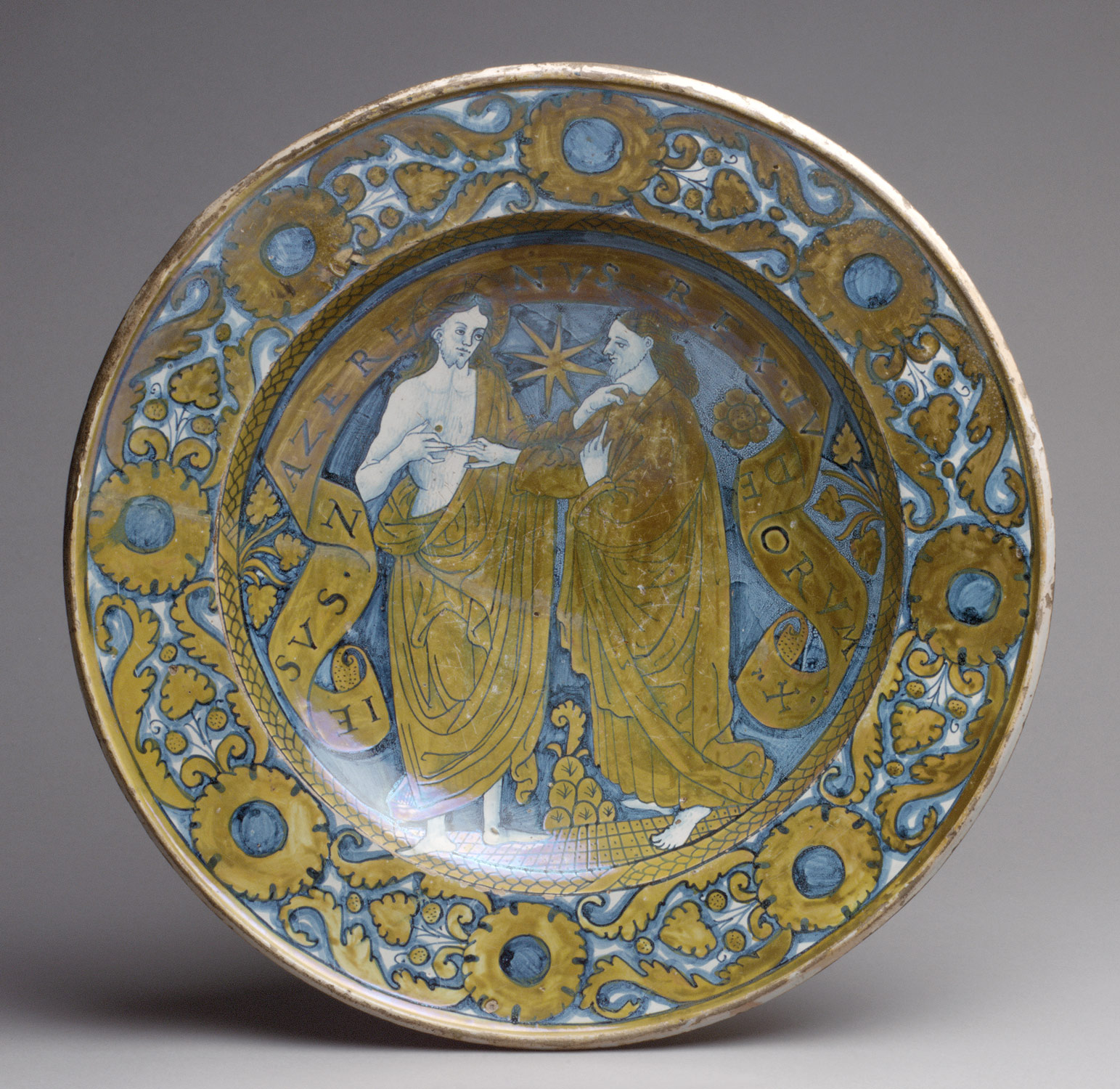
Dish, ca. 1520
Italian (Deruta)
Tin-glazed earthenware (majolica) with on-glaze blue painting and luster
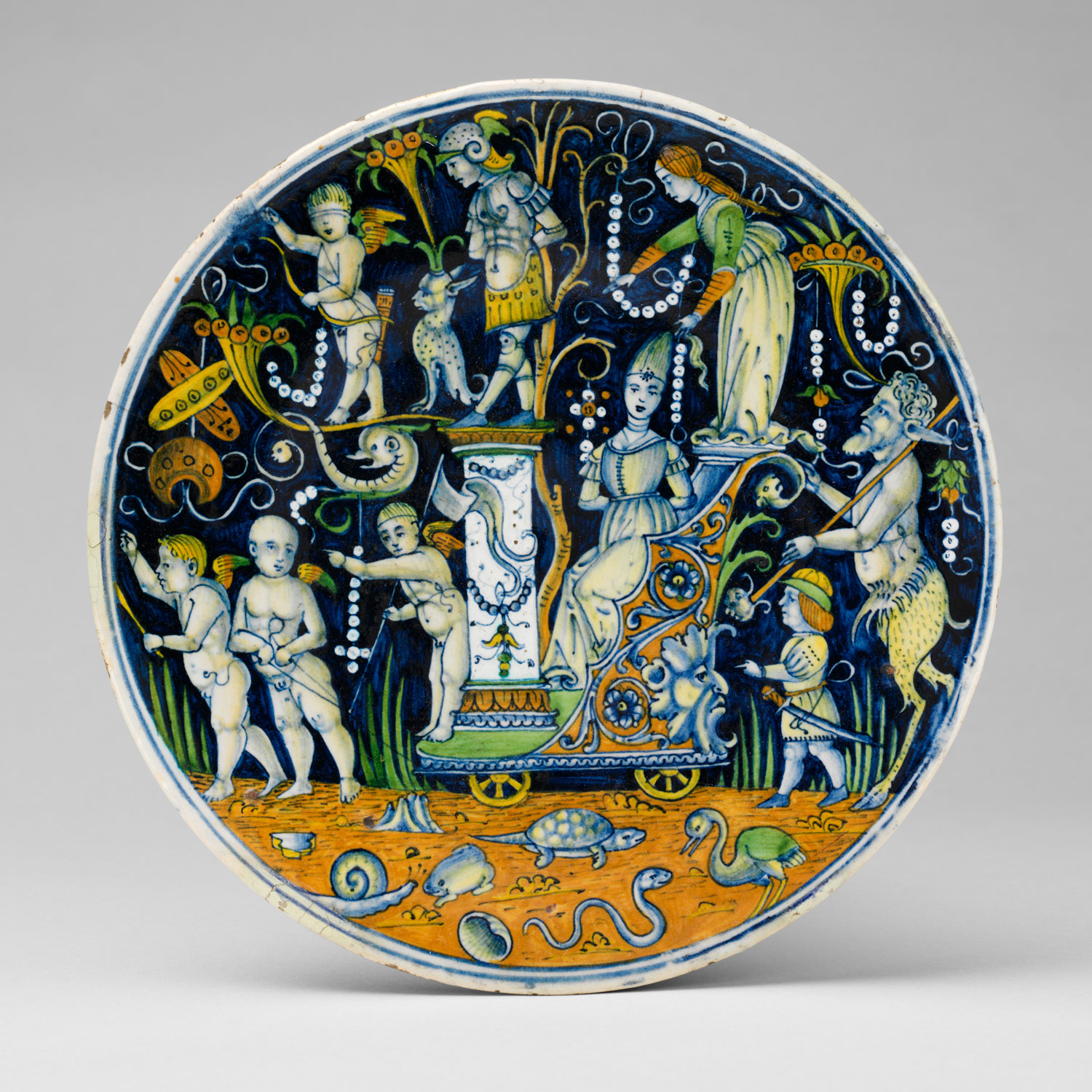
Roundel with mock Triumph of Love, ca. 1510–20
Perhaps Castel Durante or elsewhere in the Marches
Tin-glazed earthenware (maiolica)
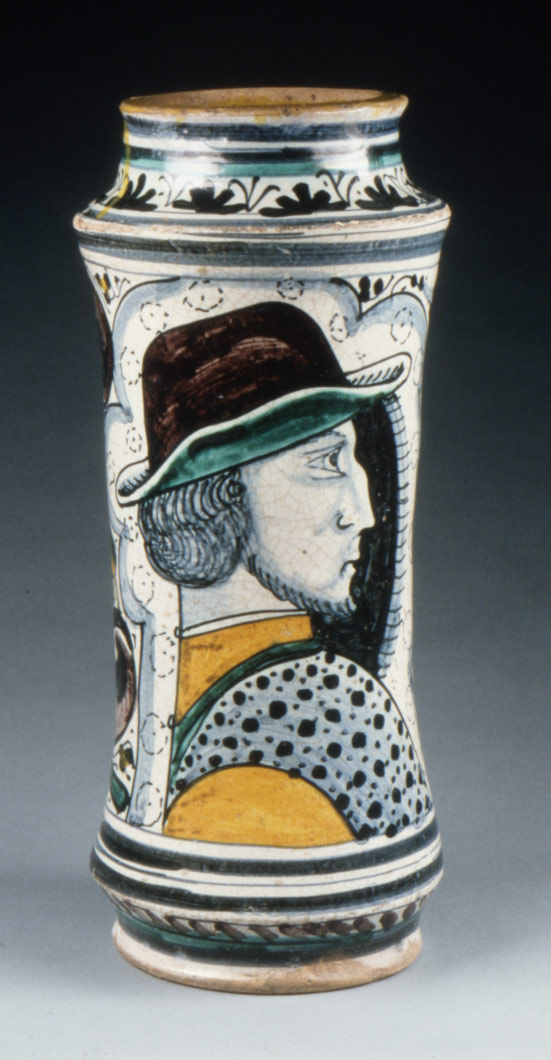
Pharmacy Jar, late 15th century
Italian (Naples)
Tin-glazed earthenware (majolica)
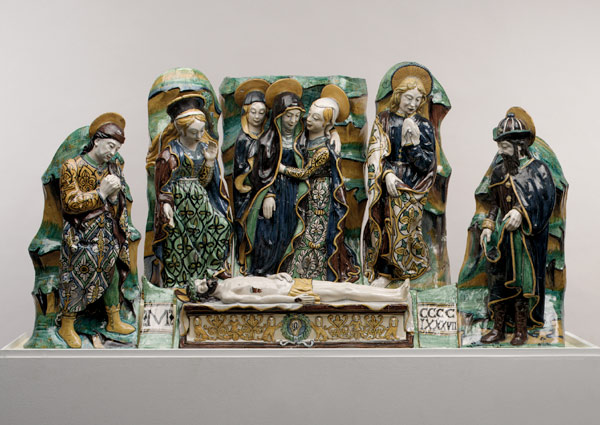
Lamentation Group, dated 1487
Italian (Faenza), probably made for a Franciscan church or convent near Faenza
Tin-glazed earthenware (majolica)
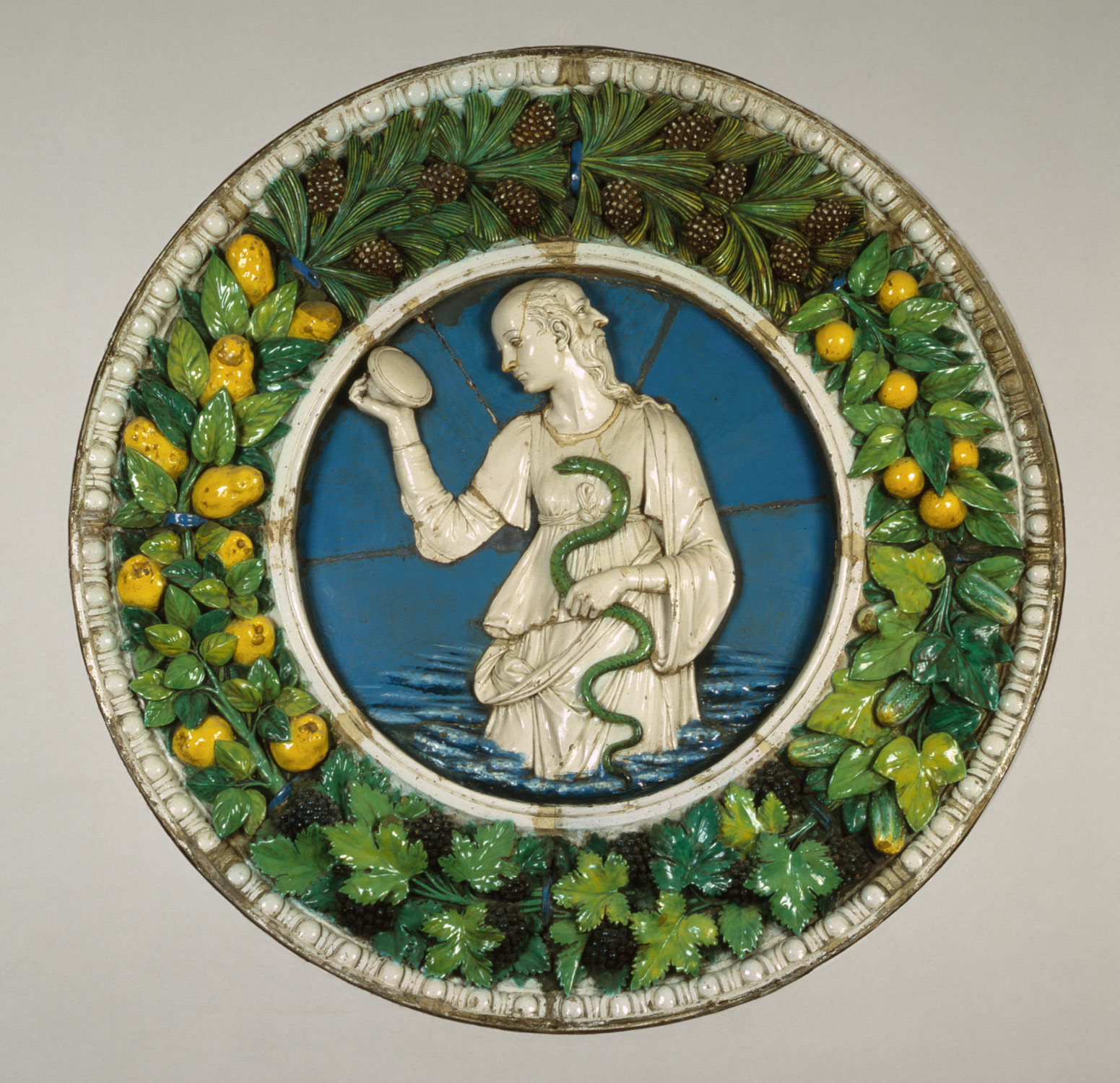
Tondo: Prudence, ca. 1475
Andrea della Robbia (Italian, 1435–1525)
Italian (Florence)
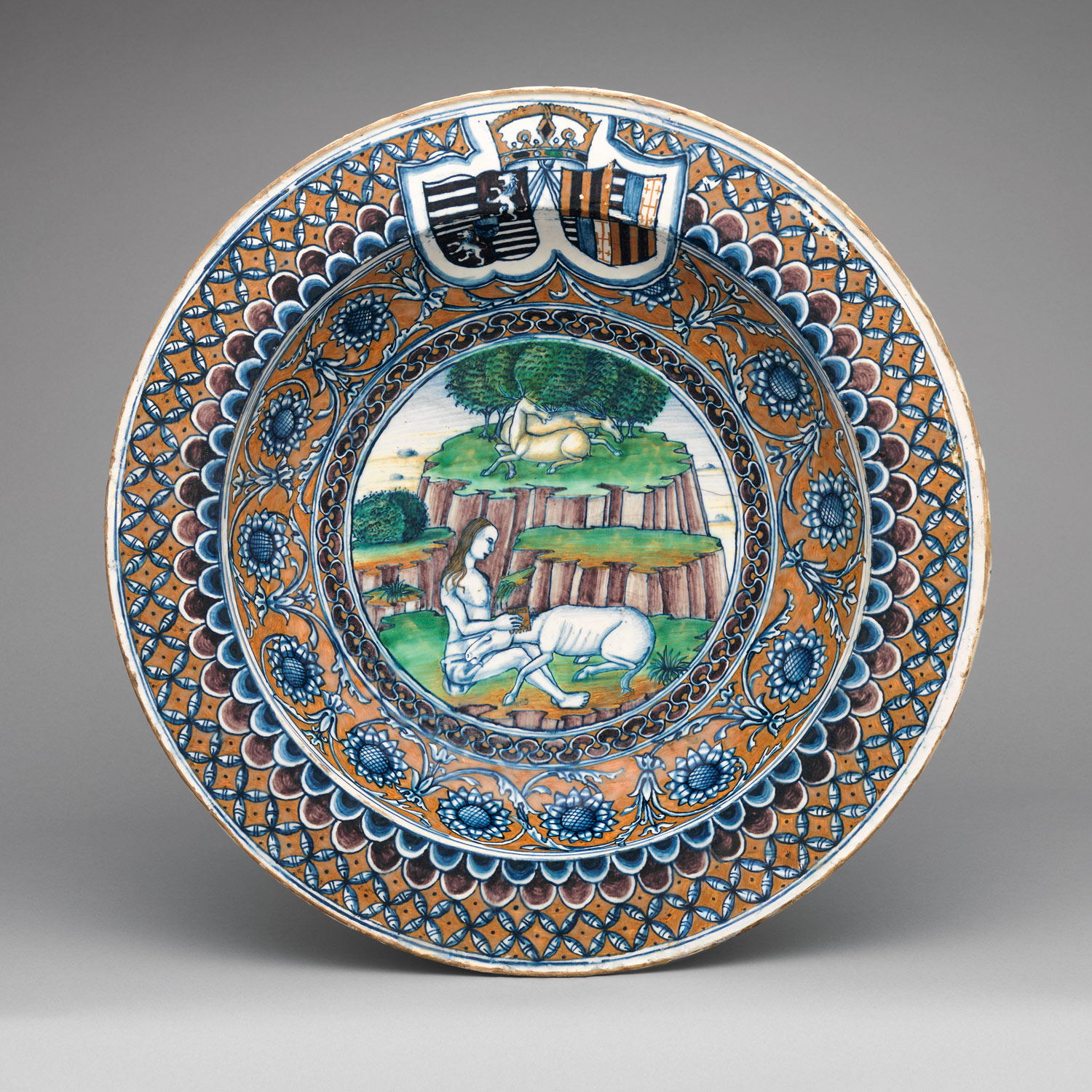
Dish with an allegory of Chastity and the arms of Matthias Corvinus and Beatrice of Aragon, 1476–ca. 1490
Probably Pesaro
Tin-glazed earthenware (maiolica)
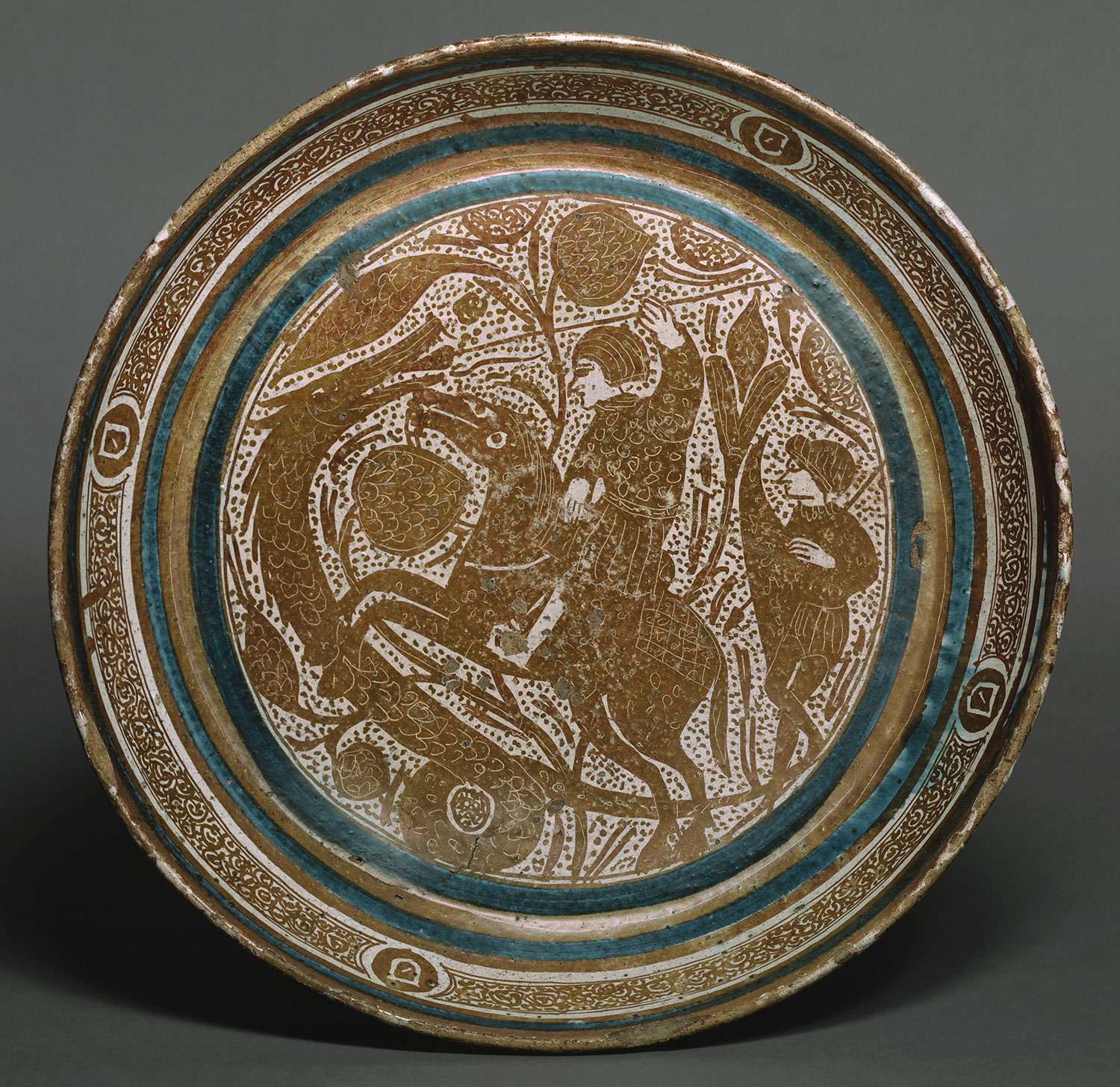
Basin with a Horseman Spearing a Serpent 1390–1400
Spanish (Valencia?)
Lustered earthenware

The Italian Renaissance maiolica tradition was taken to France by Italian potters and developed in Lyon and Nevers from the late 16th Century. The later development of this tradition in the 17th Century is demonstrated by this large and impressive dish, probably used by a high status family for formal dining.
Large oval dish with scenes from Amadis of Gaul, Urbino or Turin, circa 1560–70

Dish with portrait of a woman, c1490-c1525. Maiolica dish painted with a woman in profile, and a scroll inscribed 'PÊDORMIRENONSAQUISTA', ('nothing is gained by sleeping'). When applied to maiolica, the term 'belle donne', (Italian for 'beautiful women'), usually refers to dishes or plates bearing female heads and a scroll inscribed with a name or motto. The female image is idealised to such a degree that it is unlikely to be an accurate likeness of a particular woman. However, the names are thought to refer to contemporary women, often local worthies or beauties. Those pieces with a moralizing inscription are not belle donne wares in the true sense, but are part of the artistic tradition of portraying female images with a moralizing statement, often one that appears to be specifically addressed to a female audience. This example was made in Deruta, Umbria, Italy.

Portrait dish, (Dutch?), c1583. Portrait of a woman in Elizabethan dress with Venetian-style border decoration of fruit and flowers. In the sixteenth century, immigrant Italian potters spread the styles and techniques of painted maiolica into the Southern Netherlands; maiolica is a ceramic technique using tin-glaze which produces a surface similar to porcelain and can be easily painted. Antwerp and Haarlem also produced pottery with sophisticated decoration inspired by Italian prototypes with the town of Delft later emerging as the principal pottery centre .





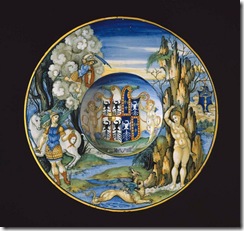
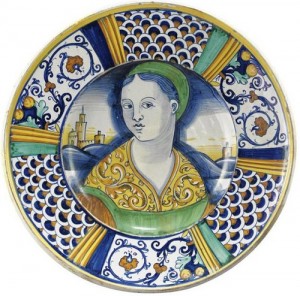

‘арфор.
»тали€ также сыграла историческую роль в развитии производства европейского фарфора. ќписани€ восточных фарфоровых изделий, оставленные одним персидским путешественником, были распространены по всей »талии и вызывали большой интерес. ¬ 1171 египетский султан —аладин послал сорок «китайских изделий» султану ¬авилона; вскоре вернувшиес€ из ≈гипта крестоносцы рассказывали о великолепии этого подарка. ¬ конце 15 в. мореплаватели привозили италь€нским правител€м восточный фарфор. ¬енецианский алхимик, маэстро јнтонио, попыталс€ воспроизвести фарфор в ≈вропе, а хроники рассказывают о давно исчезнувших предметах из псевдофарфора, который изготавливалс€ повсюду, особенно в ‘ерраре.

Italian maiolica (tin glazed earthenware) garden seat, modern, Sambuco Mario, Deruta, Italy; pedestal form, polychrome decorated in Renaissance taste with griffins and scrolling floral and foliate motifs .

¬аза ладьевидна€ с гербом ‘арнезе. ѕоследн€€ четверть XVI века
‘арфор ћедичи.
¬ эпоху –енессанса первый прорыв в производстве фарфора произошел во ‘лоренции во врем€ правлени€ ‘ранческо ди ћедичи, ¬еликого кн€з€ “осканы, правившего с 1575 по 1597, с помощью печи, разработанной Ѕоунталенти и ‘онтана. Ѕыло начато производство искусственного фарфора, известного как «фарфор ћедичи».¬ 1575 году по воле великого герцога тосканского ‘ранческо ди ћедичи устраиваетс€ мануфактура м€гкого фарфора в знаменитых флорентийских садах Ѕоболи. “ак называемый фарфор ћедичи, который по своим свойствам занимал среднее положение между твердым и м€гким фарфором, был хот€ и прозрачным благодар€ белой глине из ¬иченцы, но желтоватым, и глазурь поэтому примен€лась бела€, уже знакома€ по майоличному производству.

—охранилось примерно 50 аутентичных вещей — тарелок, блюд, подносов, полевых и паломничьих фл€г, ваз, умывальников и кувшинов. ƒекорированы они либо стилизованными цветками по образцу декора на персидской керамике, либо ветками и позаимствованными из современной италь€нской керамики гротесками с птицами, четырехглазками и маскаронами, между тем как исполнен декор кобальтом, иногда сочетаемым с синевато — лиловой краской — из окиси марганца. ћануфактура действовала до первой четверти XVII века включительно.ћарка на фарфоре ћедичи — "F" и над ним купол флорентийского собора — син€€.Ёто была сама€ успешна€ неудача в истории декоративного искусства. ак описано в трактате из флорентийской библиотеки ћаль€беке, в состав этого фарфора входило 16 частей стекл€нной фритты, 24 части песка, 12 частей белой глины из ‘аэнцы и немного каолина оттуда же; готовые издели€ покрывали свинцовой глазурью или олов€нной поливой. ѕолучалось нечто вроде глазурованного и расписанного стекла, изготовленного и украшенного гончарами, имевшего формы дальневосточных или ближневосточных изделий. Ёто был не фарфор; однако замечательно то, что эти опыты были первыми организованными меропри€ти€ми по воспроизводству фарфора в ≈вропе. ‘арфор ћедичи был предшественником французской «пат тандр» (м€гкой пасты), или м€гкого фарфора. —ами по себе эти издели€ были очень красивы; в них чувствовалось тонкое понимание духовного начала восточного искусства. Ќекоторые из них были очень удачными имитаци€ми, но не фарфора, а китайских сине-белых изделий. √ерцог ‘ранческо ди ћедичи украсил свой дворец произведени€ми фарфора ћедичи и, кроме того, использовал его в качестве дипломатических подарков другим государ€м. —охранилось всего лишь около 50 образцов фарфора ћедичи, грубоватых и т€желовесных. ѕо-видимому, не сохранившиес€ образцы были более тонкими и хрупкими, что и стало причиной их гибели.
http://www.lessing-photo.com/dispimg.asp?i=30010821+&cr=1&cl=1
http://antiquesandthearts.com/Antiques/TradeTalk/2009-09-08__10-38-00.html
http://www.veniceclayartists.com/maiolica-italian-renaissance-ceramics/
| омментировать | « ѕред. запись — дневнику — —лед. запись » | —траницы: [1] [Ќовые] |








